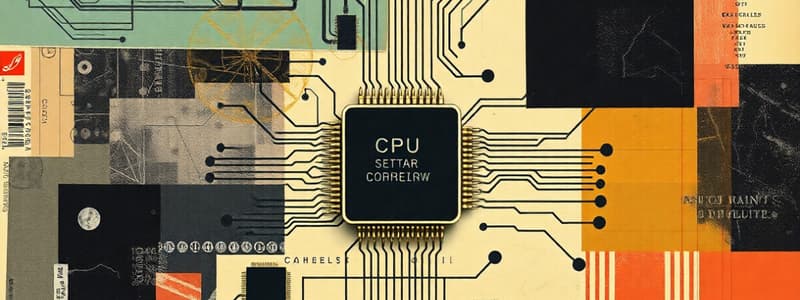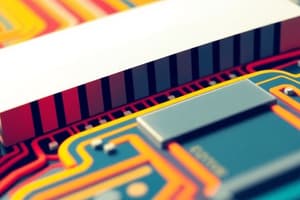Podcast
Questions and Answers
What is the maximum storage capacity of a typical 3.5-inch floppy disk?
What is the maximum storage capacity of a typical 3.5-inch floppy disk?
- 2GB
- 750MB
- 500MB
- 1.44MB (correct)
What is the function of the read/write head in a hard disk drive?
What is the function of the read/write head in a hard disk drive?
- To magnetize the disk surface
- To read data from and write data to the disk (correct)
- To protect against head crashes
- To store data permanently
Which of the following is NOT a form of secondary storage?
Which of the following is NOT a form of secondary storage?
- Secure Digital (SD) memory card
- DVD-ROM
- Random Access Memory (RAM) (correct)
- Hard Disk
What is a significant risk associated with a head crash in a hard disk?
What is a significant risk associated with a head crash in a hard disk?
What are clusters in the context of hard disks?
What are clusters in the context of hard disks?
What is the primary function of registers in the CPU?
What is the primary function of registers in the CPU?
Which operation does NOT belong to Boolean operations?
Which operation does NOT belong to Boolean operations?
What type of memory is typically used to store data needed in the near future?
What type of memory is typically used to store data needed in the near future?
What is a primary characteristic of auxiliary memory?
What is a primary characteristic of auxiliary memory?
Which of the following statements about binary notation is correct?
Which of the following statements about binary notation is correct?
Boolean operations manipulate which type of values?
Boolean operations manipulate which type of values?
What is the role of gates in computing?
What is the role of gates in computing?
What is NOT a name associated with Main Memory?
What is NOT a name associated with Main Memory?
What is a cylinder in the context of hard disk organization?
What is a cylinder in the context of hard disk organization?
How are sectors organized on a track within a hard disk?
How are sectors organized on a track within a hard disk?
What is the primary benefit of storing related data on the same cylinder?
What is the primary benefit of storing related data on the same cylinder?
Which component contributes to the seek time when accessing data on a hard disk?
Which component contributes to the seek time when accessing data on a hard disk?
What does a cluster on a hard disk refer to?
What does a cluster on a hard disk refer to?
Which of the following factors does not directly contribute to disk access speed as described?
Which of the following factors does not directly contribute to disk access speed as described?
What characteristic distinguishes sector organization in magnetic disk storage?
What characteristic distinguishes sector organization in magnetic disk storage?
What type of storage technology is characterized by data being recorded as small magnetic spots?
What type of storage technology is characterized by data being recorded as small magnetic spots?
What is a key disadvantage of using magnetic tapes for data storage compared to disks?
What is a key disadvantage of using magnetic tapes for data storage compared to disks?
Which statement accurately describes the differences between CD-R and CD-RW?
Which statement accurately describes the differences between CD-R and CD-RW?
What is one of the main advantages of flash memory over traditional disk drives?
What is one of the main advantages of flash memory over traditional disk drives?
In the hierarchy of data storage, what sequence correctly represents the organization of data from smallest to largest?
In the hierarchy of data storage, what sequence correctly represents the organization of data from smallest to largest?
What is the maximum capacity of a CD-ROM?
What is the maximum capacity of a CD-ROM?
Which type of optical disk has the highest storage capacity?
Which type of optical disk has the highest storage capacity?
What purpose does a buffer serve in a data retrieval system?
What purpose does a buffer serve in a data retrieval system?
Which technology allows for the reading of densely packed spots on a disk, enabling higher data storage capacity?
Which technology allows for the reading of densely packed spots on a disk, enabling higher data storage capacity?
What is the primary limitation of ASCII in representing languages?
What is the primary limitation of ASCII in representing languages?
Which of the following statements correctly describes Unicode?
Which of the following statements correctly describes Unicode?
What core issue occurs when a number exceeds the maximum value that can be represented in binary form?
What core issue occurs when a number exceeds the maximum value that can be represented in binary form?
In bitmap representation of images, what does each pixel in a simple black and white image represent?
In bitmap representation of images, what does each pixel in a simple black and white image represent?
How is the RGB color model represented for a single pixel in an image?
How is the RGB color model represented for a single pixel in an image?
What is the primary method used in representing sound in digital format?
What is the primary method used in representing sound in digital format?
Which of the following describes truncation in the context of numeric value representation?
Which of the following describes truncation in the context of numeric value representation?
What technique is used to create scalable image representations?
What technique is used to create scalable image representations?
Flashcards are hidden until you start studying
Study Notes
CPU Components
- The CPU is composed of two parts: the Control Unit and the Arithmetic Logic Unit (ALU).
- The Control Unit directs and controls other parts of the computer.
- The ALU executes arithmetic (+, -, ÷, x) and logical operations (AND, OR, XOR, NOT).
Registers
- Registers are temporary CPU storage areas for instructions, data, and addresses.
- Registers are faster than main memory.
- They are used to store, accept, and transfer data.
Bits and Bit Patterns
- A bit is a binary digit (either 0 or 1).
- Bit patterns represent information like numbers, text, images, and sound.
Boolean Operations
- Boolean operations manipulate one or more true/false values.
- Examples include AND, OR, XOR (exclusive OR), and NOT.
Gates
- Gates are devices that compute Boolean operations.
- They are often implemented as electronic circuits.
- They serve as building blocks for computers.
- VLSI (Very Large Scale Integration) involves using multiple gates on a single chip.
Memory Types
- Memory refers to the primary storage used for holding instructions and data being executed.
- It is also known as primary memory, main storage, internal storage, or RAM (Random Access Memory).
- Data in memory is typically lost when the computer is turned off.
Mass Storage
- Mass storage, also known as secondary storage, is used for storing data and programs for later use.
Magnetic Disk Storage
- Magnetic disk storage uses magnetized spots on a surface to represent data.
- Floppy disks were once used due to their portability and backup capabilities but are no longer common.
- Hard disks (HD) consist of rigid platters coated with magnetic oxide.
- Hard disks are known for their speed and capacity, with storage capacities reaching hundreds of gigabytes.
- Both removable and non-removable hard drives are available.
Hard Disk Organization
- Track is the circular portion of the disk surface that passes under the read/write head.
- Sector is a small arc on a track where information is recorded. Each sector typically holds 512 bytes of data.
- Zone recording allocates more sectors to outer tracks for more efficient storage use.
- Cluster is a fixed number of adjacent sectors treated as one unit of storage (typically 2-8 sectors).
- Cylinder consists of the same track number on all platters in a disk pack.
Hard Disk Access Speed
- Access time is the time it takes to read data from a hard disk.
- It comprises three components: seek time, head switching time, and rotational delay.
- Seek time is the time needed for the access arm to move over the desired track.
- Head switching refers to activating the specific read/write head for the targeted track and surface.
- Rotational delay is the time required for the desired data to rotate under the read/write head.
Magnetic Tape Storage
- Data is stored as magnetic spots on tape.
- Types include 3.5-inch reels, 3.5-inch cartridges, and cassette tapes.
- Tape storage capacity is measured in characters per inch (CPI) or bytes per inch (BPI).
Disk vs. Tape Storage
- Disks offer faster access and greater reliability but are more expensive.
- Tapes are mainly used for backups due to their lower cost.
Optical Disk Storage
- Data is represented by spots created using lasers on a metallic surface.
Compact Disks (CDs)
- CD-ROM drives can only read data from CDs.
- CD-R drives can write to a disk once.
- CD-RW drives can erase and rewrite data multiple times.
Digital Versatile Disk (DVD)
- Using a shorter wavelength laser, DVDs can store larger amounts of data than CDs.
- DVD drives can read both DVDs and CDs.
- DVDs are popular for storing full-length movies with improved sound quality compared to CDs.
Blue-ray Disks
- Blue-ray disks offer approximately five times more storage capacity than DVDs.
Flash Memory
- Flash memory is non-volatile RAM.
- Flash drives and Secure Digital (SD) Memory cards are popular examples.
- Advantages include reduced power consumption and smaller size compared to disk drives.
Files
- A file is a unit of data in mass storage systems.
- Fields are groups of characters within a file.
- Key fields are used to identify records.
- Physical record is a block of data conforming to the characteristics of a storage device.
- Logical record is a natural division of data within a file, which could be paragraphs or pages for text documents.
File Storage and Retrieval
- Buffer is a temporary storage area used during data transfers.
- Key identifies records uniquely.
Representing Information as Bit Patterns
- ASCII uses 7-bit patterns to represent text characters, primarily for English.
- Unicode utilizes 16-bit patterns for broader language support, covering languages like Chinese, Japanese, and Hebrew.
Representing Numeric Values
- Binary notation uses bits to represent numbers in base two.
- Overflow occurs when a value is too large for the computer to represent.
- Truncation happens when a value cannot be represented accurately.
Representing Images
- Bit map techniques utilize pixels (picture elements) to represent images.
- Each pixel is represented by one or more bits, depending on the image's complexity.
- RGB (Red, Green, Blue) color model uses three bytes per pixel to represent color intensity.
- Analytic geometry techniques, such as TrueType and PostScript, provide scalable image representations.
Representing Sound
- Sampling techniques record sound by capturing the amplitude of the sound wave periodically.
- The sample rate specifies the number of samples captured per second (e.g., 8000 samples per second).
- The captured numeric values are then transmitted to the receiving end.
Studying That Suits You
Use AI to generate personalized quizzes and flashcards to suit your learning preferences.




